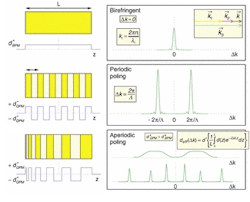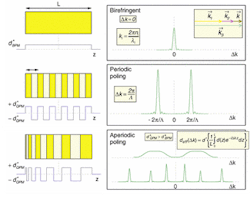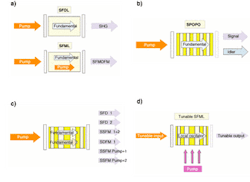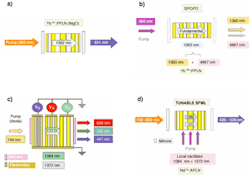Self-frequency-converted lasers enable a broad range of applications
Nonlinear frequency conversion provides a valuable tool to generate laser radiation in spectral regions that are difficult or otherwise impossible for other conventional laser sources to reach. It also helps in translating desirable operating characteristics for a given laser to spectral ranges other than the laser's natural oscillation range. Frequency-doubling solid-state neodymium (Nd3+) or ytterbium (Yb3+) infrared lasers, for instance, provides green emission and translates characteristics like miniaturization, ruggedness, portability, or compactness to spectral ranges formerly dominated by argon or other ion-gas lasers.
The keys to achieving efficient nonlinear frequency conversion are high power density of the interacting waves, a long interaction length, and a high nonlinear response of the crystal (nonlinear effective coefficient deff). In addition, it is necessary to keep a suitable phase relationship between the interacting waves—known as "phase matching."1 Frequency conversion in a nonlinear crystal external to the laser is generally useful for pulsed lasers, in which high-peak-power pulses can be achieved even with modest average powers, allowing high single-pass conversion efficiencies. An improvement comes from placing the external nonlinear crystal in a resonant cavity and mode matching the laser and cavity modes.
In the early 1960s a frequency-conversion technique was proposed particularly for continuous-wave lasers, in which the peak power (equal to the average power) is typically orders of magnitude less than that of pulsed lasers and the conversion efficiency in external crystals is less efficient. Frequency-conversion efficiency was improved by placing a nonlinear crystal inside the solid-state-laser cavity because the intracavity power density is typically about two orders of magnitude higher than at the laser output. Intracavity conversion of a small fraction (around a few percent) of the power available in the fundamental laser equals the power that would be obtained in a 100% efficient external conversion.2
In an even more integrated approach, laser oscillation and nonlinear frequency conversion can be performed in the same laser crystal. If a nonlinear host crystal is doped with laser-active ions, a single crystal may provide an intracavity frequency-converted laser in what is known as a self-frequency-converted (SFC) laser. In 1969 Johnson and Ballman reported self-frequency-doubling in a pulsed thulium doped lithium niobate (Tm3+:LiNbO3) laser crystal.3 Later, in 1986 Fan and his colleagues reported a green self-frequency-doubled laser operating continuous-wave and based on Nd3+:LiNbO3(MgO) (see "Self-frequency-doubling with birefringence" on page 148).4
Quasi-phase-matching
Although efficient and useful, self-frequency-converted lasers based on birefringent phase-matching (BPM) have fundamental limitations. On one hand, waves of orthogonal polarization need to be mixed. As a consequence the highest nonlinear response of the material, which is a tensor-like property related to the polarization vectors of the interacting waves, cannot generally be accessed. On the other hand, only one nonlinear process can be phase-matched at a time, according to the specific direction of interacting wave propagation within the crystal. In addition the propagation direction is frequently far-removed from the principal crystallographic axes. So a double-refraction effect results with two directions for energy and phase propagation that subtend what is known as a "walk-off" angle. The effect limits the effective nonlinear interaction length—in many cases making it shorter than the crystal length. Birefringent phase-matching also poses stringent tolerances for wavelength, angle, or temperature changes and may leave no possibility of achieving phase matching for a given interaction in a given crystal. Stable operation of SFC lasers that rely on birefringent phase-matching, for instance, typically requires thermal stabilization within tenths of a degree.
Quasi-phase-matching (QPM) is an alternative to birefringent phase-matching, however, for maintaining a productive phase relationship among interacting waves and enabling efficient nonlinear interactions beyond the limitations of birefringent phase-matching.1 Quasi-phase-matching can be realized in ferroelectric nonlinear crystals such as LiNbO3, lithium tantalate (LiTaO3), and potassium titanyl phosphate (KTP), strontium barium niobate (SBN) and barium sodium niobate (BaNaNNA) through a spatial distribution of ferroelectric domains in which the direction of spontaneous polarization is reversed in adjacent domains. The resulting pattern imposes a spatial modulation on the nonlinear figure of merit of the crystal (see Fig. 1).
null
The technique allows walk-off-free nonlinear interactions to occur within the transparency region of the crystal and allows the effective nonlinear interaction length to coincide with the entire crystal length. In addition, the highest nonlinear component of the nonlinear tensor (usually the diagonal term d33) can be accessed by mixing waves of equal polarization (electric field parallel to the ferroelectric c-axis). In the well-known cases of periodically poled lithium niobate or KTP (PPLN and PPKTP), a periodic distribution of domain reversals with a 50% duty cycle provides efficient walk-off-free interaction, as well as a nonlinear figure of merit roughly four times (in LiNbO3) the figure of merit for birefringent phase-matching, leading to 16 times more efficiency.
A self-frequency-doubled laser based on periodically poled lithium tantalate (LiTaO) doped with Nd3+ was reported by Abedin et al. in 1996.5 But the ability to quasi-phase-match is not limited to single-conversion devices. Creating an aperiodic (rather than periodic) distribution of ferroelectric domains in the crystal allows simultaneous quasi-phase-matching for multiple interactions (see Fig. 2), increasing wavelength, thermal or angle tolerances considerably, or even allowing for interactions in which one or more of the waves are tunable.6
FIGURE 2. Schematics represent self-frequency-converted laser devices based on domain-engineered host crystals using BPM in a monodomain ferroelectric crystal (a); a self-pumped optical parametric oscillator in a periodically poled crystal (b); simultaneous generation of multiple wavelengths by combination of multiple-channel oscillation and multiple nonlinear interactions in an aperiodically poled crystal (c); and an active frequency converter for tunable lasers based in an aperiodically poled crystal (d).
Numerous applications
A straightforward application of aperiodic domain distributions is to avoid the stringent temperature stabilization requirement of the nonlinear crystal in birefringent phase-matched systems. For instance a continuous-wave self-frequency-doubled laser that avoids thermal stabilization can be designed based on Yb3+:PPLN(MgO),7 and other devices have been demonstrated that benefit from the increased nonlinear coefficient, walk-off-free operation and interaction multiplicity of quasi-phase-matching in aperiodically poled crystals (see Fig. 2 and 3a).7
In a continuous-wave self-pumped optical parametric oscillator, the fundamental laser radiation can be used to pump a 1-mm-long intracavity optical parametric oscillator (see Fig. 2b).8 The output wavelength can be selected by setting a particular spatial period of the domain distribution. An Yb3+:LiNbO3 (MgO) self-pumped optical parametric oscillator can provide continuous-wave infrared laser radiation in a chip diode-pumped crystal covering the whole 1.1 to 7-µm range (see Fig. 3b).9
Another pioneering example is an active converter for tunable lasers (see Fig. 2d and 3d).10 Here, the laser beam of a tunable laser is injected into the cavity of a laser based on a domain-engineered laser crystal. Self-sum-frequency-mixing of the external laser wave and the intracavity laser wave or waves (local oscillator wave/waves) results in trackingless heterodyne frequency conversion and yields a tunable laser system with an emission band that differs from that of the original tunable laser in the energy (either sum or difference) of the local oscillator photon energy.
null
Taking a step further, one encounters the possibility of combining multiple-channel laser oscillation and multiple nonlinear interactions in the same self-frequency-converted laser (see Fig. 2c). A device that achieves the long-pursued goal of simultaneous generation of red, green, and blue emission from the same laser crystal has been demonstrated based on this principle. In this RGB device, two laser channels at 1084 and 1372 nm are simultaneously oscillated and mixed with the longitudinal pump radiation at 744 nm from a diode laser. Simultaneous self-frequency-doubling of both laser channels and self-sum-frequency-mixing with pump laser radiation provides red, green, and blue generation.11
Of late, the possibility of exploiting the electro-optic effect in combination with quasi-phase-matching has gained attention. It is possible, for example, to achieve tunability or stabilization of self-pumped optical parametric oscillators, or to control the amount of frequency conversion.12 The resulting flexibility enables, for instance, adding independent color control in the RGB device described above, or intensity modulation of a frequency-converted output (see Fig. 3c).
Such devices are simply early examples of a novel technology with a vast horizon of possibilities. All of the principles discussed in this article apply to waveguide devices as well. So one can anticipate that the near future will reveal novel devices based on self-frequency-converted lasers that combine multiple oscillation and/or multiple nonlinear processes in the same miniaturized or integrated system.
REFERENCES
- J. A. Armstrong et al., Phys. Rev. 127, 1918 (1962).
- R. G. Smith, IEEE J. Quant. Electron. 6, 215 (1970).
- L. F. Johnson and A.A. Ballman, J. Appl. Phys. 40, 297 (1969).
- T. Y. Fan, et al., J. Opt. Soc. Am. B3, 140 (1986).
- K. S. Abedin, et al., Appl. Phys. Lett. 70, 10 (1996).
- M.M. Fejer, et al., IEEE J. Quant. Electron. 28, 2631 (1992).
- J. Capmany et al., Appl. Phys. Lett. 76, 1374 (2000).
- J. Capmany et al., Laser Focus World, 37(6), 143 (2001).
- J. Capmany et al., Appl. Phys. Lett. 79, 293 (2001).
- J. Capmany et al., Appl. Phys. Lett. 79, 1751 (2001).
- J. Capmany. Appl. Phys. Lett. 78, 144 (2001).
- N. O'Brien, et al., Opt. Lett. 24, 1750 (1999).
JUAN CAPMANY is a professor in the Dpto. Física y Arquitectura de Computadores, Universidad Miguel Hernández, Avda. Ferrocarril s/n E030202 Elche (Alicante), Spain; e-mail: [email protected].
Self-frequency-doubling with birefringence
Since the late 1980s, research on self-frequency-converted lasers has focused on self-frequency-doubled (SFD) lasers based on intracavity second-harmonic generation of fundamental laser waves around 1060 nm, associated with the 4F3/2→4I11/2 laser channel of neodymium (Nd3+) embedded in dielectric nonlinear birefringent crystals. The goal has been to develop compact diode-pumped solid-state laser sources of green radiation for optical data storage due to the early lack of laser diodes in this spectral region.
A few years ago, research attention also extended to self-frequency-doubled green lasers based on the 2F5/2→2F7/2 laser channel of ytterbium (Yb3+) ions and to red lasers based on the 4F3/2→4I13/2 laser channel of Nd3+. In principle, blue lasers based on the quasi-three-level laser channel 4F3/2→4I9/2 of Nd3+ are also possible. Efficient self-frequency-doubled lasers in both continuous-wave and pulsed mode have been demonstrated in the green. Pulsed self-frequency-doubled lasers are generally based on passive Q-switching with an intracavity chromium yttrium aluminum garnet (Cr4+:YAG) saturable absorber crystal.
An extension of the principles involved in self-frequency-doubled lasers to a broader set of self-frequency-converted lasers has started only recently. For instance, generation of blue and UV laser radiation by intracavity sum-frequency mixing of the fundamental laser wave with resonant longitudinal laser pump radiation in Nd3+ based lasers has been reported in a self-sum-frequency-mixing laser (SSFM laser).1
Several ion-host combinations have been used in self-frequency-converted lasers based on birefringent phase-matching. Outstanding performance has been found in SFD lasers based on borate crystals like yttrium aluminum boarate (YAl3(BO3)4), yttrium calcium oxyborate (YCa4O(BO3)3), gadolinium calcium oxyborate (GdCa4O(BO3)3). The two last have proved useful for mass-production of self-frequency-doubled lasers because of the possibility of growing large-size crystal boules of high optical quality doped with laser-active ions.
An attractive feature for miniaturization of self-frequency-converted lasers is the possibility of pumping rare-earth active ions like Nd3+, Yb3+, or erbium (Er3+) with commercially available laser diodes. Diode-pumped microchip SFD lasers of order 1 × 1 × 1 mm with dielectric mirrors directly deposited on the crystal faces have been reported. These microchip SFD lasers fit well inside the package of a laser diode, and all they require to achieve a highly efficient SFD laser is a minute aspheric or GRIN lens, which also fits well inside the laser diode, to focus the laser-diode pump on the chip crystal.
REFERENCES
- D. Jaque et al., Appl. Phys. Lett. 73, 3659 (1998).



